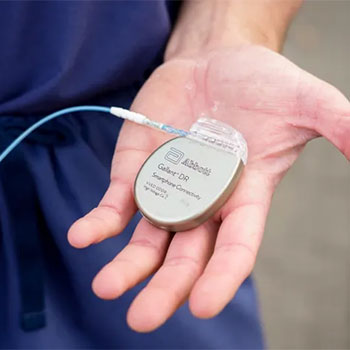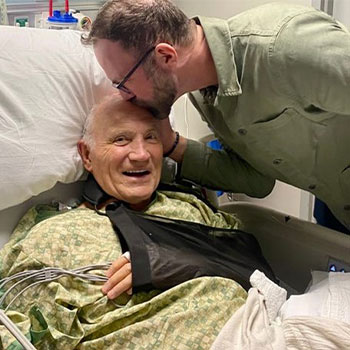
Seventeen years ago, Matt’s life hung in the balance on a high school football field as quick-thinking bystanders used an automated external defibrillator (AED) to save him from a sudden cardiac arrest. Today, he has turned a traumatic experience into a lifelong mission to advocate for cardiac health. On a cool evening last December in Pflugerville, Texas, during a high-stakes football game, fate called upon him to return the lifesaving favor in a dramatic twist. This is the story of how Matt Nader, a former Westlake offensive lineman turned Abbott territory manager for arrhythmias, stepped into a crucial role off the field.
Q: Can you walk us through the moment when you noticed Bill Wolters on the ground in the parking lot? What was going through your mind at that time?
A: "We were just leaving a football game when I noticed Bill and his wife ahead of me. Suddenly, I heard a loud crack; it was different than a normal fall—it was clear he landed on his head. He was motionless, which is never a good sign. I immediately recognized it as a severe situation since I'd seen similar scenarios before, and I rushed to assist him."
Q: How did your own experience of having your life saved during a football game influence your actions when you saw Bill in distress?
A: "My own experience was instantly recalled. I knew exactly what was happening because I had been in a similar situation. I recognized the signs of cardiac arrest right away, which is probably why I reacted so quickly. My past experience definitely shaped my ability to respond effectively."
Q: Reflecting on this experience, what do you think were the most crucial factors that contributed to saving Bill’s life?
A: "The immediate start and continuance of CPR was crucial, coupled with the timely use of an AED. Also, having the knowledge and recognizing the signs of cardiac arrest played a significant role. It was a combination of quick response, the availability of an AED, and teamwork with the first responders that saved his life."
Q: Can you share any specific memories or moments from your conversation with Bill and his son, Casey Wolters, at the hospital?
A: "After the incident, visiting Bill in the ICU was a profound moment. He was groggy but alive. His son asked me if I was the one who saved his father's life, which was very moving. It’s incredible to see the impact of your actions firsthand."
Q: Can you share any insights or lessons you've gained from this experience that you think could benefit others who may find themselves in a similar situation? What do you hope people take away from Bill’s story and your role in it?
A: “People should know that CPR is a vital skill that can save lives. Don't be afraid to step in and help; the bystander effect is real, and it's often up to individuals to act. I hope my story inspires more people to learn CPR and recognize the signs of cardiac arrest. "
Q: How do you think your advocacy work, particularly in ensuring AEDs are available in public schools, has contributed to situations like the one with Bill?
A: "My advocacy work has certainly made environments safer by ensuring AEDs are more accessible. This experience has only strengthened my resolve to continue promoting awareness and the importance of quick action during cardiac emergencies. The city of Pflugerville actually declared April 26 as Sudden Cardiac Arrest Awareness Day to help promote life-saving response actions."
Q: How do you personally cope with the intensity and emotional weight of being involved in life-or-death situations like this one?
A: "It's certainly intense but knowing that you can make a difference helps manage the emotional weight. Also, understanding that what I do has a positive impact gives me a sense of purpose. Being an example of how an internal defibrillator can protect you and allow you to live a normal life shows patients that they are not alone, and I’m humbled to provide that for others."
Q: Given your background in working with defibrillators and your involvement with the Championship Hearts Foundation, how do you see your work evolving considering this recent experience?
A: "This incident has reinforced the importance of my work. I see myself continuing to advocate for better preparedness for cardiac emergencies, both through technology and education, along with preventative measures, such as offering free heart screenings for Texas teens."
Q: Looking ahead, what are your goals or aspirations in terms of raising awareness about CPR and AED use?
A: "Sudden cardiac death is one of the leading causes of death and is treatable. I want to continue raising awareness about the importance of quick action and the use of AEDs in public spaces. Ensuring people understand how to use these life-saving tools is key."
Q: How has this experience shaped your perspective on life and the value of human connection and compassion?
A: "This experience has underscored the importance of compassion and community support in emergencies. It’s shown me how crucial human connection is and how a single moment can unite people in the most critical times. Additionally, the subsequent implantation of an Abbott defibrillator in Bill—which, incredibly, is the same model defibrillator that was implanted in me—illustrates the role of advanced medical technology in extending care beyond the emergency and connects back to my work at Abbott. This intersection of technology and compassionate care reinforces our collective commitment to enhancing patient lives, reminding us of the profound impact we can have on one another."


Matt 's story is a powerful testament to the impact of education, preparedness, and courage in the face of emergencies. It underlines the importance of widespread CPR training and the availability of AEDs in saving lives. As someone who has been both a receiver and a giver in life-saving situations, Matt embodies the spirit of resilience and community service. His actions not only saved a life but also serve as a compelling call to action for others to learn about cardiac health and emergency response. In a world where every second counts, people like Matt remind us of the profound difference one person can make, armed with the right knowledge and the courage to act.
Learn more about how patients like Bill can benefit from Abbott’s leading-edge implantable cardioverter defibrillators (ICDs), and how our technology is transforming lives. Visit our ICD technology page to see how we are personalizing and optimizing therapy for every patient.


MAT-2407284 v1.0
Stay Connected